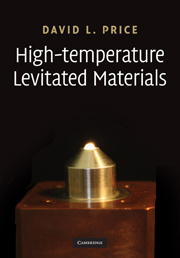7 - Molten semiconductors
Published online by Cambridge University Press: 23 April 2010
Summary
In this chapter we discuss some elements that are semiconducting in the solid state and that, because of their relatively high melting points and interest in their supercooled liquid states, have been the subject of investigation with levitation techniques. The first materials to be discussed – silicon, germanium and their alloys – in fact melt into metals, albeit, as we shall see, metallic liquids with quite unusual properties.
Silicon
Silicon crystal growth and crystal properties are important in the semiconductor industry. Silicon is the host material for the majority of semiconductor applications, and the properties of its crystalline, amorphous and liquid phases are of substantial interest. The atomic structure, electrical, optical and thermophysical properties of the liquid phase are key factors that determine the quality of crystals grown from the melt. Mito et al. (2005) have made numerical simulations of Czochralski growth of silicon crystals and found that the Peclet number and deflection of the melt–crystal interface, two important parameters in the growth process, are highly sensitive to the emissivity, thermal conductivity, temperature coefficient of surface tension in the liquid as well as the emissivity and thermal conductivity of the crystal. A graphic representation of the importance of thermophysical properties of the liquid for numerical modelling of crystal growth is given in Fig. 7.1.
The conductivity and other electrical transport properties of liquid Si and Ge have been measured by several authors in contained samples.
- Type
- Chapter
- Information
- High-Temperature Levitated Materials , pp. 131 - 161Publisher: Cambridge University PressPrint publication year: 2010

